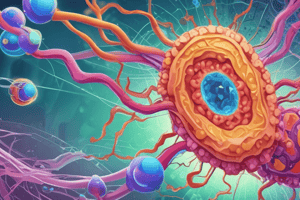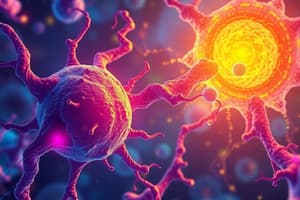Podcast
Questions and Answers
Who is best known for the improvement of the microscope and observing single-cell organisms?
Who is best known for the improvement of the microscope and observing single-cell organisms?
- Matthias Schleiden
- Theodor Schwann
- Antonie van Leeuwenhoek (correct)
- Rudolf Virchow
What is one of the fundamental principles of Cell Theory established by Theodor Schwann and Matthias Schleiden?
What is one of the fundamental principles of Cell Theory established by Theodor Schwann and Matthias Schleiden?
- All living organisms are composed of one or more cells. (correct)
- Cells are the same in all living organisms.
- All cells contain DNA.
- Cells can spontaneously generate.
Which statement correctly reflects the third tenet of Cell Theory added by Rudolf Virchow?
Which statement correctly reflects the third tenet of Cell Theory added by Rudolf Virchow?
- All cells exhibit spontaneous generation.
- All cells arise only from pre-existing cells. (correct)
- All cells can survive independently.
- All cells have identical DNA.
What concept concerning living organisms was discarded by Cell Theory?
What concept concerning living organisms was discarded by Cell Theory?
What is referred to as the smallest living unit of structure and function of all organisms?
What is referred to as the smallest living unit of structure and function of all organisms?
How does the module aim to complement students' education?
How does the module aim to complement students' education?
What type of resources are recommended for students in the module?
What type of resources are recommended for students in the module?
What is a key purpose of lectures in this module?
What is a key purpose of lectures in this module?
What structural feature distinguishes eukaryotic cells from prokaryotic cells?
What structural feature distinguishes eukaryotic cells from prokaryotic cells?
What is a primary function of proteins in cells?
What is a primary function of proteins in cells?
Which of the following distinguishes prokaryotic cells from eukaryotic cells?
Which of the following distinguishes prokaryotic cells from eukaryotic cells?
How do the sizes of eukaryotic cells generally compare to prokaryotic cells?
How do the sizes of eukaryotic cells generally compare to prokaryotic cells?
What is a primary difference between the chromosome structure of eukaryotes and prokaryotes?
What is a primary difference between the chromosome structure of eukaryotes and prokaryotes?
What is the role of the cell membrane?
What is the role of the cell membrane?
What are the chromosome structures in eukaryotic cells made of?
What are the chromosome structures in eukaryotic cells made of?
Which type of microscopy utilizes fluorescent dyes for staining samples?
Which type of microscopy utilizes fluorescent dyes for staining samples?
Which of the following is NOT a fundamental activity of cells?
Which of the following is NOT a fundamental activity of cells?
What is the approximate maximum useful magnification of a light microscope?
What is the approximate maximum useful magnification of a light microscope?
Which organelles are generally absent in prokaryotic cells?
Which organelles are generally absent in prokaryotic cells?
What is the defining property of the resolving power of an optical microscope?
What is the defining property of the resolving power of an optical microscope?
In which type of cell is DNA free-floating rather than enclosed?
In which type of cell is DNA free-floating rather than enclosed?
What type of ribosomes do eukaryotic cells contain compared to prokaryotic cells?
What type of ribosomes do eukaryotic cells contain compared to prokaryotic cells?
What is a primary feature of eukaryotic cells regarding organelles?
What is a primary feature of eukaryotic cells regarding organelles?
What is the cytoplasm of a cell?
What is the cytoplasm of a cell?
What is the fundamental reason electron microscopy provides higher resolution images than light microscopy?
What is the fundamental reason electron microscopy provides higher resolution images than light microscopy?
Which type of electron microscope is most similar to a conventional light microscope in terms of how it generates images?
Which type of electron microscope is most similar to a conventional light microscope in terms of how it generates images?
What type of detailed information can Scanning Electron Microscopy (SEM) provide?
What type of detailed information can Scanning Electron Microscopy (SEM) provide?
What is the primary role of membrane lipids in a cell?
What is the primary role of membrane lipids in a cell?
What characteristic do all membrane lipids share?
What characteristic do all membrane lipids share?
What feature of phosphatidic acid is crucial for its role in cell membranes?
What feature of phosphatidic acid is crucial for its role in cell membranes?
Which of the following polar groups can be attached to the phosphoryl group in membrane phospholipids?
Which of the following polar groups can be attached to the phosphoryl group in membrane phospholipids?
What is the maximum useful magnification for a Transmission Electron Microscope (TEM)?
What is the maximum useful magnification for a Transmission Electron Microscope (TEM)?
Which is a fundamental activity of cells?
Which is a fundamental activity of cells?
What type of information do electron microscopy images provide regarding cellular structure?
What type of information do electron microscopy images provide regarding cellular structure?
Flashcards are hidden until you start studying
Study Notes
Basic Cell Biology Concepts
- Introduces fundamental principles of cell structure, function, and organization.
- Covers topics including biological macromolecules, molecular biology, cell communication, and genetics.
Learning Outcomes
- Understanding of key concepts in cell and molecular biology.
- Ability to design, perform, and analyze simple experiments.
Working with Lectures
- Active note-taking is crucial for understanding the material.
- Lectures aim to help students understand rather than just memorize facts.
Assessment Information
- Two assessment components:
- In-class test (4th December 2023)
- Lab report (Canvas submission by 2pm on 24th November 2023)
The Iceberg Illusion: Success
- This is a placeholder for a concept not explained in the provided text.
Textbooks
- Essential Cell Biology, Fifth Edition by Bruce Alberts, et al.
Key Historical Figures
- Antony van Leeuwenhoek
- Known for improving the microscope.
- Considered the "Father of Microbiology."
- First to observe and describe single-cell organisms (microorganisms), which he called "animalcules."
- Also observed muscle fibers, bacteria, spermatozoa, and blood flow in capillaries.
The Cell Theory
- A fundamental theory in biology.
- Developed in the early 19th century.
- Proposed that all living things are composed of cells.
- Formulated in 1839 by Theodor Schwann and Matthias Schleiden.
Principles of Cell Theory
- All living things are made of cells.
- The cell is the most basic unit of life (structure and function).
- All cells arise only from pre-existing cells (disproving spontaneous generation). This was added to the theory by Rudolf Virchow in 1855.
Characteristics of All Cells
- A surrounding membrane (cell membrane).
- Cytoplasm: the cell interior, excluding the nucleus.
- Organelles: structures within the cell that have specific functions (e.g., mitochondria).
- Intracellular DNA: either within a membrane-bound nucleus or not.
Prokaryotic Cells
- Thought to be the first cell type on Earth.
- Include bacteria and archaea (two domains of prokaryotes).
- Unicellular organisms.
- Lack a membrane-bound nucleus.
- Their DNA is concentrated in a region called the nucleoid.
- Do not have membrane-bound organelles (essentially no organelles).
Eukaryotic Cells
- Have DNA enclosed within a membrane-bound nucleus.
- DNA is organized into linear chromosomes that store genetic information.
- Possess many membrane-bound organelles.
- Generally larger than prokaryotic cells.
- Form the basis of all complex multicellular organisms (plants, animals, and fungi).
Differences Between Eukaryotic and Prokaryotic Cells
| Feature | Eukaryotes | Prokaryotes |
|---|---|---|
| Nucleus | Membrane-bound nucleus | No nucleus |
| Chromosomes | Two or more linear chromosomes, DNA | One circular chromosome |
| bound to proteins (histones) | ||
| Introns | Introns and repetitive DNA | Introns found in archaebacteria |
| Ribosomes | Larger ribosomes (80S/18S) - outside | 70S/16S |
| the nucleus | ||
| Cytoskeleton | Actin/tubulin filaments for support | Absent |
| and motility | ||
| Organelles | Internal membrane systems (organelles) | Absent |
| Size | 2-1000 microns (typically 10-100) | Typically about 1 micron (0.5-50) |
Microscopy
- A fundamental tool for studying cells.
- Brightfield microscopy: The simplest form of light microscopy.
- Sample is illuminated from below.
- White light is transmitted through the sample.
- Generally low contrast.
- Fluorescence microscopy: Uses fluorescent dyes (fluorochromes) for staining cells.
- Similar to ordinary light microscopy but uses specific filters to excite and detect fluorescence.
Limits of Light Microscopy
- Limited by the wavelength of light (visible light ranges 380-750 nm).
- Maximum useful magnification of about 2000X.
- Resolving power: the shortest distance between two points on a specimen that can be distinguished as separate entities.
- This depends on the wavelength of illuminating light with shorter wavelengths providing higher resolution.
Electron Microscopy (EM)
- Uses high-energy electrons (shorter wavelengths) for illumination.
- Provides much higher resolution images than light microscopy.
- Used to visualize the structures of cells and cellular components.
Transmission Electron Microscope (TEM)
- Analogous to a compound light microscope, but uses electrons instead of light.
- Electrons are transmitted through the specimen (placed in a vacuum).
- Contrast is generated by staining with electron-dense materials that absorb or scatter electrons.
- Can achieve magnifications up to 500,000X with a resolution of 0.5 nm.
Scanning Electron Microscope (SEM)
- Scans the specimen surface with a focused electron beam.
- The specimen is coated with a thin layer of heavy metal.
- Detects secondary electrons emitted from the surface.
- Produces 3D images of objects, revealing surface details with high resolution.
- Maximum useful magnification is around 100,000x with a resolution of 3-20 nm.
The Cell Membrane
- Defines the boundary of a cell.
- Essential for cellular activities.
- Composed of lipids and proteins.
- Different cell types have different proportions of lipids and proteins.
Membrane Lipids
- Amphipathic: have both polar (hydrophilic) and nonpolar (hydrophobic) regions.
- Form a bilayer structure in membranes:
- Tails point inwards, heads point outwards.
- Allows for separating two aqueous environments.
Glycerophospholipids
- Most abundant membrane lipids.
- Based on glycerol-3-phosphate.
- Long-chain fatty acids are esterified to two of the hydroxyl groups.
- A polar molecule (X) can be attached to the phosphoryl group, forming a variety of different head groups.
- Examples of polar groups (X): choline, serine, ethanolamine, and inositol, forming phosphatidylcholine, phosphatidylserine, phosphatidylethanolamine, and phosphatidylinositol, respectively.
Studying That Suits You
Use AI to generate personalized quizzes and flashcards to suit your learning preferences.




